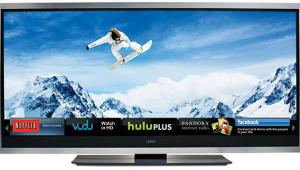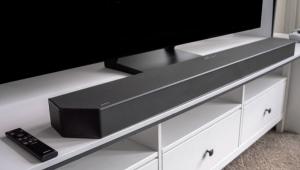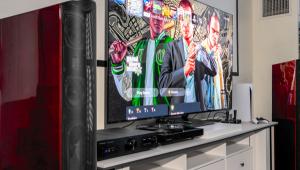Samsung 75" QN900D 8K QLED TV represents the pinnacle of home entertainment technology, boasting stunning visuals and cutting-edge features. With its massive 75-inch display, viewers are treated to an immersive viewing experience unlike any other.
Samsung 75" QN900D 8K QLED TV Review
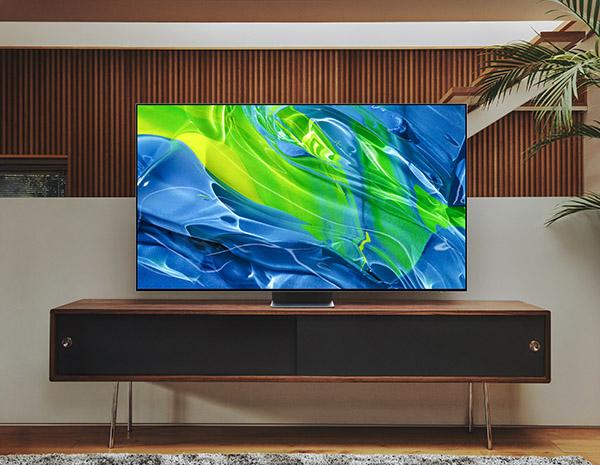
AT A GLANCE
Plus
Significantly brighter HDR peak luminance than 2023
Great gaming features
Attractive design, nearly invisible bezel border
ATSC 3.0 over-the-air tuning
Attractive and snappy smart TV interface
Minus
Screen picks up room reflections when using stand.
Continued dearth of native 8K content
Lacks codecs like VVC likely to be used with future 8K content
No Dolby Vision support
THE VERDICT
Samsung's QN75QN900D Neo QLED 8K TV impresses with bright HDR, smart features, and AI game mode, offering stunning visuals from 4K and Full HD sources. Its speed and responsiveness make it a top choice for gaming, appealing to those willing to invest in premium 8K technology.
The QN75QN900D Neo QLED is Samsung's 2024 flagship 8K mini-LED LCD TV series, and it delivers a brilliantly bright, colorful, and detailed picture from most content. The series replaces last year's flagship Samsung 8K Neo QLED, offering a thinner panel design, significantly brighter picture, up to a 144Hz native refresh rate for advanced gaming, and includes the company's out-boarded One Connect box allowing for a very-thin panel depth and perfectly flat back, so it fits flush against a wall despite being a full array backlit display with local dimming.
The Neo QLED technology leverages quantum dot color technology for high color volume along with notable accuracy. Quantum dots and mini-LEDs together boost peak HDR and SDR brightness while maintaining contrast using more than 1,000 local dimming zones. This produces greater control over fine shadow detail while elevating peak HDR luminance levels—we measured nearly 2400 nits! This produces life-like HDR specular highlights that preserve color details nicely in cinematic content, live video, and video game graphics.
This year, Samsung has introduced the third generation of the Neural Quantum 8K AI Processor. It makes images look lifelike and colorful by using Samsung's color tone mapping technology. Our tests showed it's great at rendering bright, accurate colors. It does this even beyond the wide DCI-P3 color range. It does this without adding any noticeable embellishment or artifacts. The AI processing in the latest model enhances 4K HDR content to almost 8K quality on a scene-by-scene basis. It also provides exceptionally clear native 8K images, although there are only a few 8K videos available to test this with.
The TV's advanced 8K AI video processing effectively enhances native 4K UHD content. However, the 75-inch model we tested struggled to fully improve content with insufficient video image information, embodying the principle of "garbage in, garbage out." The large screen, despite its additional 8K pixels, made some low-resolution SD and HD programs—typical of certain YouTube videos—appear softer and less vibrant compared to their appearance on smaller 4K UHD screens.
Among the highlights of 2024's new features, the 8K UHD NQ8 AI Gen 3 "Neural Quantum" processor stands out, boasting double the speed of last year's model and an eightfold increase in neural networks (from 64 to 512). This leap allows for crisper image details from most sources. The processor powers several innovative picture quality enhancements. These include 8K AI Upscaling Pro, which sharpens lower-resolution content for optimal display on premium 8K screens, and AI Motion Enhance Pro, designed to reduce artifacts like ball distortion in live sports. It automatically identifies the sport to tailor deep learning adjustments to the motion of balls, pucks, and similar objects.
Additionally, the introduction of the Real Depth Enhance Pro system marks a significant advance. Utilizing AI, this system boosts detail in fast-moving scenes by more precisely adjusting the mini-LED backlight zones. This suite of technologies exemplifies the processor's role in elevating picture quality to unprecedented levels, showcasing the potential of AI in transforming viewing experiences. Samsung also includes Auto HDR Remastering intended to improve 4K color and contrast using AI-based algorithms to generate brighter highlights in non-HDR content.
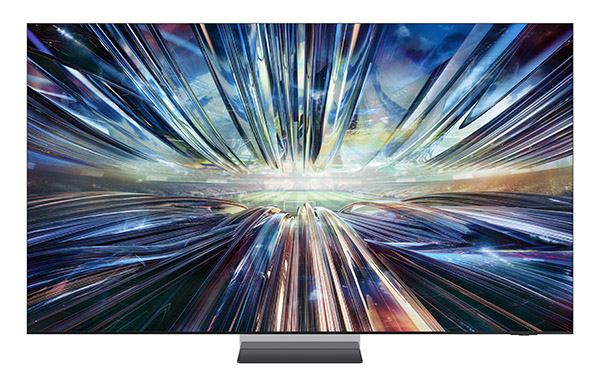
The QN900D TV series is available in 65-inch ($4,999.99 suggested retail price), 75-inch ($6,299.99), and 85-inch ($7,999.99) screen sizes.
Design
Among its many strengths, the set's design stands out, enhanced by the external One Connect Box that offers more placement options and less visible cable clutter. This feature also enables the mini-LED LCD screen to be mounted flush against a wall with an optional thin-profile bracket.
The 75QN900D cabinet design includes an ultra-thin bezel frame around the screen. This black trim border tends to blend in well with the picture, helping to create the illusion of a picture almost floating in space. The screen itself measures just 1.5 inches deep, 65 inches long and 37-inches tall (edge to edge).
Samsung includes a sleek metal and plastic pedestal stand for table-top placement, featuring a slim foot plate that sits a quarter inch above the surface and extends 4.5 inches in front of the screen. The stand design provides a 2.5-inch clearance between its base and the TV's bottom edge, accommodating sound bars. With an 11-inch depth from front to back, the stand fits a broad selection of credenzas and home theater cabinets.
Unpacking
For assembling the 75-inch and larger models, it's advised to have at least two people set up the TV on the supplied pedestal stand or an optional wall bracket. The process is straightforward, thanks to pre-installed mounting posts on the screen's rear and corresponding slots on the two-part stand, which easily slide together via pin fasteners. However, for the 75-inch model reviewed, those with young children or active pets should note the screen may wobble slightly on the stand after a light push. The structure is generally secure, though caution is advised in environments with frequent rough play.
The One Connect box, containing most of the display's circuitry and ports, connects to the panel with a proprietary connector and measures 11.5 inches by 13 inches by 1.5 inches. Samsung provides a short strap for attaching the box to the stand's back and a longer silver cable for positioning it to the side or beneath the display, extending about 8 feet. This cable, also carrying power, should not be run inside walls to prevent fire hazards.
Features
The QN900D's Tizen 8.0 smart TV interface is enhanced by Samsung's Gen 3 8K processor for quicker, more user-friendly interactions. It supports voice control through Bixby or Alexa, with input from the remote's button-activated mic or the TV's far-field mics. Google Assistant devices can also connect. The updated interface features a Sub Tab row for personalized recommendations across "For You," "Live," and "Apps" categories. It offers a vast app library and integrates with smart home platforms via Samsung SmartThings and Apple AirPlay 2. An optional USB camera supports video conferencing and health apps.
The One Connect box provides four HDMI 2.1 ports, including an eARC/ARC port for audio setups, supporting up to 4K/120p HDR10, Variable Refresh Rate, FreeSync Premium Pro, and Auto Low Latency Mode. Additional ports include three USB 2.0, EX-Link, antenna/cable for ATSC tuners, optical, LAN (Ethernet), an RS-232 control port, and a USB-C for an optional camera.
Samsung's Eco Remote, now dubbed the "SolarCell Remote," is a slim, wand-style controller with a built-in rechargeable battery. It features a small solar panel on the back for charging via sunlight or room light, as long as it's placed panel-side up. Users can also charge it via a USB-C cable. Navigation is facilitated by a large circular pad, with voice commands enabled through a mic button. It includes direct buttons for Amazon Prime Video, Disney+, Netflix, and Samsung TV Plus, along with standard controls for home, playback, volume, and channels.
The Samsung 75QN900D has a 6.2.4-channel 90-Watt sound system. It is made to maximize audio quality in a slim body. It uses AI to tailor the sound to the room's acoustics. The 2024 version introduces enhanced Q-Symphony, syncing the TV's sound with external wireless speakers and compatible Samsung Q-Symphony sound bars. This integration adds subwoofers and rear channels. It enriches the soundstage, especially with Dolby Atmos content which makes the experience more immersive.
When using its internal speakers, the TV employs Active Voice Amplifier and Adaptive Sound Pro+ to optimize dialogue clarity and background sound for the environment. Additional features include Bluetooth connectivity, Clear Dialogue enhancement, and support for Dolby Digital Plus, Dolby Atmos, and Dolby 5.1 decoding. However, DTS codecs are not supported natively on the TV platform.
Other audio features encompass Multiroom Link, Moving Sound Pro (for object-tracking sound), SpaceFit Sound, Sound Mirroring, Sound Optimizer Pro Surround Sound, and Voice Guide.
Performance
This TV supports High Dynamic Range (HDR) content, including HDR10, HDR10+ (Adaptive), and HLG profiles, but lacks Dolby Vision compatibility. However, Dolby Vision content will default to HDR10 mode on Samsung sets. The differences between Dolby Vision and HDR10 are very subtle, and most won’t notice anything is missing. If you want a full dynamic metadata HDR experience, you can look for HDR10+ supported movies and programs to play on this set, but again, the differences with HDR10 are not extreme.
Measurements were taken using a Portrait Display's C6-HDR colorimeter, Murideo Six-G test pattern generator and the latest version of Portrait Displays Calman software.
In Filmmaker Mode, our measurements showed HDR10 peak luminance surpassing 2,365 nits using a 10% D65 white window test pattern. The TV, featuring 1,344 local dimming zones managing thousands of mini-LED backlights, delivers exceptional contrast performance for an LCD-based display.
However, compared to Samsung's flagship QN900D 2024 8K Neo QLED model, some shadow details are lost, notably in challenging scenes like the evil wizard attack from Harry Potter & the Deathly Hallows Part 2.
In low brightness scenes, such as the opening titles of The Martian UHD Blu-ray, some star details were lost, and brighter scenes showed slight haloing around stars, as seen in the Spears & Munsil 4K UHD test disc. This effect was less pronounced than in Samsung's 2024 4K QN90D but comparable to the 2024 4K Quantum OLED 65S95D model. If deep blacks and minimal blooming are key for you, consider OLED options like Samsung's 2023 4K S95C Quantum OLED or OLED TVs from Sony and LG, though this may mean sacrificing some of the QN900D's peak brightness.
This year, Samsung introduced its Auto HDR Remastering feature, designed to enhance non-HDR content by boosting brightness cues to simulate bright 4K color and contrast using AI-based algorithms. Despite the potential for brighter highlights and details, we found that most SDR content appears more natural without this feature activated.
The 75QN900D excels in displaying the professional P3 wide color gamut used by Hollywood studios when mastering movies in HDR. The TV coverwd 91.73% of the 1931 CIE xy axis and 93.95% of the CIE 1976 uv coordinates, surpassing the Ultra HD Alliance's "premium UHD TV" threshold of 90%. This alliance includes content creators and electronics manufacturers.
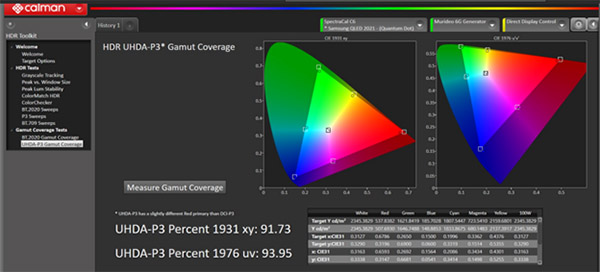
Measured HDR P3 color gamut coverage using Portrait Displays HDR evaluation workflow. Measurements taken with Portrait Displays Calman software.
Like last year, Samsung provides the option to use static or dynamic tone mapping for managing color presentation and detail in out-of-range shades. While effective as needed, it can be overly intense for some content. The set accurately reproduces most P3 colors commonly encountered. In Filmmaker Mode, static tone mapping is activated automatically, ensuring colors remain vibrant as intended by the director. The set’s dynamic tone mapping adds a realistic overall appearance where peak color brightness begins to roll off.
In Filmmaker mode, the Ultra HD Blu-ray of BBC's Blue Planet II displayed reef fish colors as brilliantly rich and well saturated. Their natural vibrancy stood out amidst the variable HDR brightness flashes from sunlight penetrating the clear water.
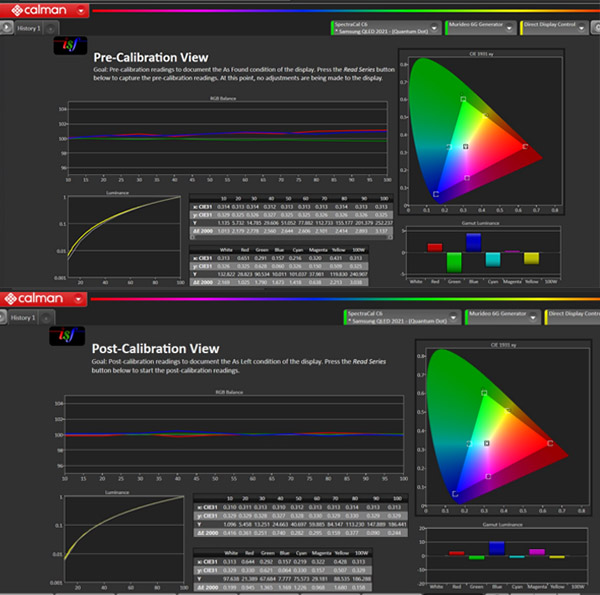
Pre- and post-calibration views showing SDR in Filmmaker Mode from measurements taken with Portrait Displays Calman software.
Standard dynamic range (SDR) images were also nicely bright and accurate after a slight adjustment for gamma and white point.
While Filmmaker Picture Mode disables these features, the 900D provides various motion processing options to enhance clarity in fast-moving content and reduce judder in camera pans. For gamers, the set supports up to 144Hz input for content and the panel itself offers a native 240Hz refresh rate.
Gaming
The QN75QN900D delivers fast gaming, with an input lag of 3.8ms for both 1080/60p and 4K/60p signals across its four HDMI ports. This can automatically activate with ALLM using the new AI Auto Game Mode.
The AI Auto Game Mode stands out as one of the QN900D's significant new AI features. Samsung developed algorithms to eliminate the inconvenience of manually adjusting picture quality and sound modes for specific game titles. This mode simplifies gaming setup by automatically optimizing TV settings for various gaming genres based on the incoming title signal.
In "Auto" mode, AI detects the game being played and adjusts settings accordingly—for instance, activating "Sports" mode for a soccer game or "FPS" settings for a first-person shooter, streamlining the gaming experience.
If you primarily play one game genre, you can manually select the specific setting and disable "Auto" mode. With "Auto" mode active, connecting a gaming console via HDMI triggers the AI Auto Game Mode. Once the game begins, the AI engine automatically adjusts to the optimal picture and sound settings.
Audio
The TV's internal speakers deliver clear dialogue and a somewhat wide, dispersed sound field for music. But like any TV the limitations the flat panel design creates limitations for what can be done with the built-in audio. Voices were noticeably directional, with sound obviously emanating from behind the screen, as compared to an outboard home theater setup with true multichannel speakers placed out and around in the listening area. Bass tones of the on-board system were somewhat deep for a TV, but lacked the dynamics and punch afforded by an external subwoofer.
We lacked a Q-Symphony compatible sound bar to test this year's enhancements in integrating the TV's speakers with the sound bar's drivers. However, we anticipate performance will be as excellent as last year's, and substantially better than the TV's own speaker system.
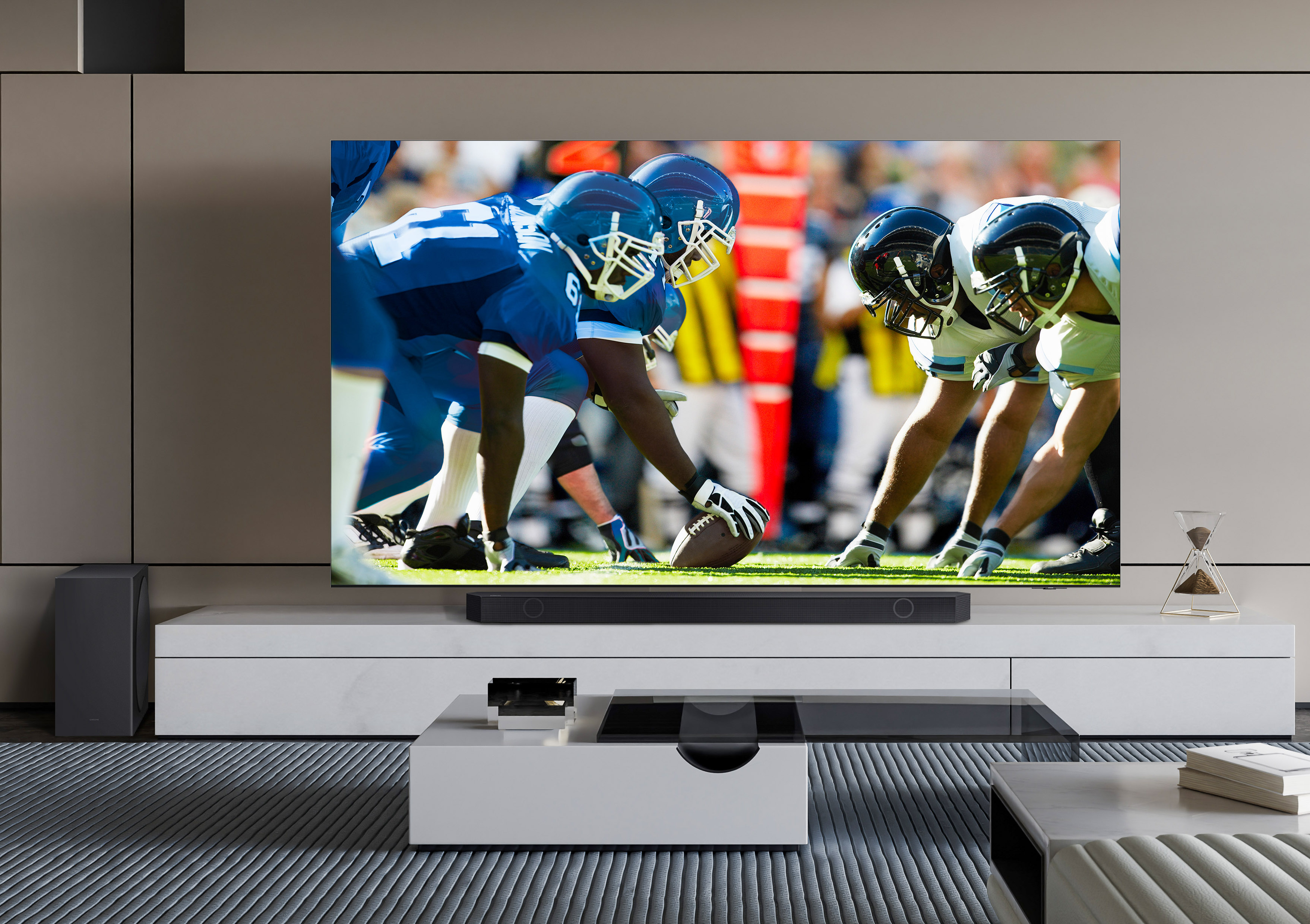
The QN900D is pictured here with Samsung's Q990D soundbar.
Conclusion
The Samsung 75-inch 75QN900D 8K Neo QLED Mini-LED TV stands out as a superior home theater display featuring an internal ATSC 3.0 NextGen TV tuner, unlike Samsung’s 2024 4K UHD TVs. This addition may become increasingly important as U.S. broadcasters transition from ATSC 1.0, expanding content resolutions and other capabilities offered by the emerging hybrid over-the-air/internet-based NextGen TV standard.
The 75QN900D makes this flagship series much brighter. But, its color gamut doesn't match the new Samsung S95D Quantum OLED series. It still beats the 90% P3 standard for premium UHD TVs. It offers an impressive array of features and automatic settings tailored for advanced gamers. If you can afford this top-tier 8K model, you're unlikely to be disappointed. It stands out as one of the premier 8K TVs of 2024, notably as one of the few new 8K UHD models released that year.
This higher resolution comes at a premium, yet launch prices are anticipated to decrease during promotional periods throughout the year. Early adopters and affluent gamers will likely appreciate the impressively bright, upscaled 4K HDR images this TV produces. However, its value proposition remains subject to discussion and will depend on the intended use. This is not the TV you buy just to watch HD on cable.
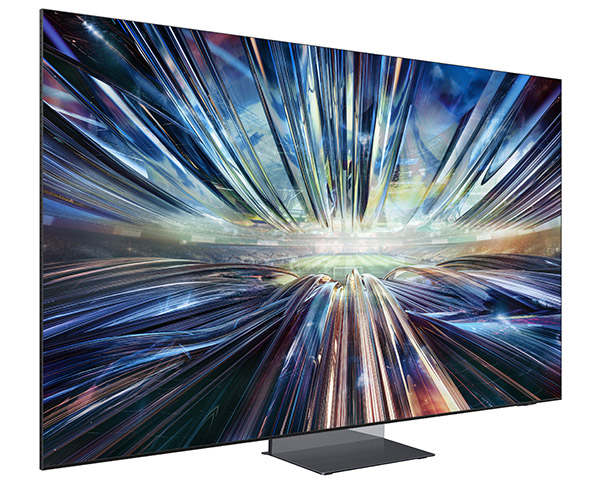
Specs
Dimensions
Set Size with Stand: 65.2 x 40.1 x 11.2 (WxHxD)
One Connect Box: 14.2 x 1.3 x 13 (WxHxD)
Weight
Set Weight with Stand (lb): 87.7
Set Weight without Stand (lb): 66.7
Video Inputs
4X HDMI 2.1 (with eARC)
Audio
6.2.4 Ch, Dolby Atmos, OTS+, Q-Symphony, Adaptive Sound Pro
The Samsung 77QN900D used for this review was set up for us to test at a Samsung facility using our own test equipment and demo material.
- Log in or register to post comments















